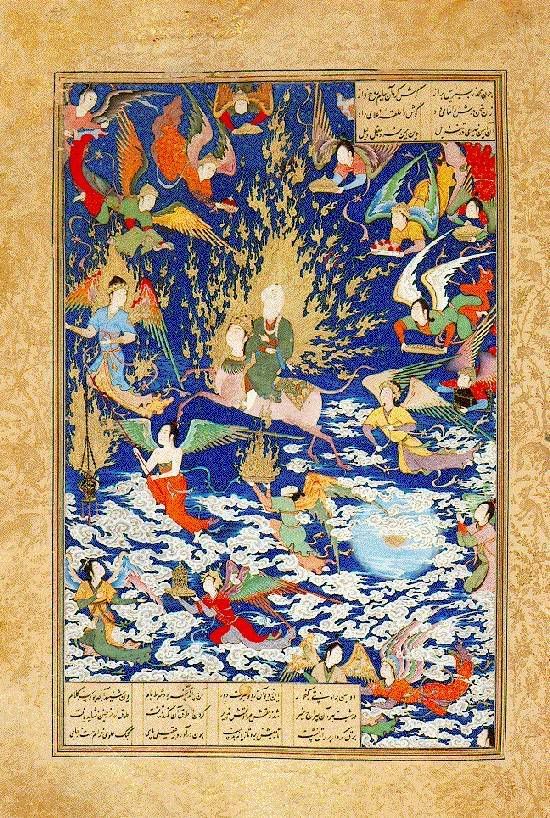
In Islamic tradition, the Isra and Mi'raj (Arabic: الإسراء والمعراج, al-’Isrā’ wal-Mi‘rāğ) are the two parts of a journey that Muhammad took from Al-Masjid al-Ḥarām to al-Masjid al-Aqsa than to heavens in one night, around the year 620. Many Muslims consider it a physical journey but some Islamic scholars consider it a dream.
The Isra begins with Muhammad resting in the Kaaba in Mecca, when the archangel Gabriel (Jibril) comes to Him, and brings Him the winged steed Buraq, who carries Muhammad to Al-Aqsa Mosqu (the farthest mosque). The location of this mosque was not explicitly stated in the Qur'an, but is traditionally considered to be the Noble Sanctuary (Temple Mount) in Jerusalem. There, Muhammad alights, tethers Buraq, and leads other prophets in prayer. He then gets back on Buraq, and in the second part of the journey, the Mi'raj, is taken to the heavens, where he tours the circles of heaven, and speaks with the earlier prophets, and with Allah. Allah tells him to enjoin the Muslims to pray fifty times a day; however, Moses tells Muhammad that they would never do it, and urges Muhammad to go back several times and ask for a reduction, until finally it is reduced to five times a day.
Al-Masjid al-Ḥarām (المسجد الحرام [ʔælˈmæsʤɪd ælħɑˈrɑːm] "The Sacred Mosque"), is the largest mosque in the world. Located in the city of Mecca, it surrounds the Kaaba, the place which Muslims turn towards while offering daily prayers and is considered by Muslims as the holiest place on Earth. The mosque is also commonly known as the Grand Mosque, Haram or Haram Sharif.
Al-Aqsa Mosque (Arabic:المسجد الاقصى, /æl'mæsʒɪd æl'ɑqsˁɑ/, al-Masjid al-Aqsa translit: "the Farthest Mosque"), also known as al-Aqsa, is an Islamic holy place in the Old City of Jerusalem. The mosque itself forms part of the al-Haram ash-Sharif or "Sacred Noble Sanctuary", a site also known as the Temple Mount and considered the holiest site in Judaism, since it is believed to be where the Temple in Jerusalem once stood. Widely considered, mainly by Sunni Muslims, as the third holiest site in Islam, Muslims believe that prophet Muhammad was transported from the Sacred Mosque in Mecca to al-Aqsa during the Night Journey.
Though at the time of the Isra and Mi'raj, there was no mosque in that location, the term "the farthest Mosque" in verse (17:1) of the Qur'an is traditionally interpreted by Muslims as referring to the site at the Noble Sanctuary (Temple Mount) in Jerusalem. This interpretation is agreed with by even the earliest biographer of Muhammad — Ibn Ishaq — and is supported by numerous Hadith. The term used for mosque (masjid), literally means "place of prostration", and includes monotheistic places of worship such as Solomon's Temple, which in verse 17:7 (in the same sura) is described as a masjid.
No comments:
Post a Comment